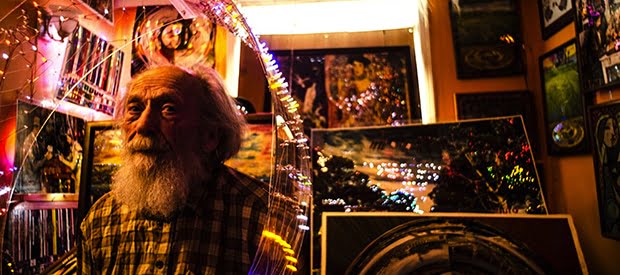Quick stats about the movie
- Director:
Maisie Jacobson - Genre:
Documentary - Year:
2016 - Duration:
19:15 - Language:
English - Province:
ON
In a tiny Montreal apartment, thousands of LED lights flash, illuminating bizarre portraits and fantastical machines.
In the midst of the chaos sits 85-year-old visionary artist Bill Anhang, hard at work on his latest creation. But what happens when Bill takes his quirky show to NYC for his first major exhibition?
Creative team
Writers: Joshua Eisen, Maisie Jacobson
Director: Maisie Jacobson
Producers: Joshua Eisen, Alison MacMillan
Filmmaker’s statement
Bill Anhang is an enigma. Even after getting to know him over the course of the last year and a half – on long shoots in Montreal and New York and during the innumerable visits, emails and phone calls in between – we’re still not quite sure what to make of him.
By turns loquacious, cryptic, insightful and rambling, Bill is animated by an intense creative impulse that can be hard to wrap one’s head around. His cluttered Montreal apartment-cum-studio space – Billsville – is a psychedelic wonderland of flashing lights, half-finished paintings and discarded electrical circuitry.
Stepping out into the icy cold of a Montreal winter’s evening after our first visit, I remember thinking to myself “What the hell just happened?” And while we’ve grown close to Bill as he has let us into his life in the intervening year, some of that bafflement remains. Who is this kooky old dude and what is he trying to get at?
Bill’s artwork – a unique bricolage of paintings, images and LED lights that he variously refers to as backlit, loop and bib art – would likely fall under what art critics and their ilk have termed “outsider art.” The term, coined by critic Roger Cardinal in the early seventies, refers to work created beyond the margins of the mainstream art world by artists who are largely self-taught.
According to Cardinal, outsider artists and their creations often occupy an unusual space along the psychosocial spectrum, from the eccentric biographical paintings of Joe Coleman to the schizophrenic fantasy worlds of the Austrian asylum inmate Adolph Wölfli. Often, outsider artists report being inspired by religious or spiritual experiences and see their work as part of a sacred mission – the case with Georgia Baptist minister Howard Finster, whose rambling Paradise Gardens sculpture park was inspired by a divine message to “paint sacred art.”
Pretty much across the board, the work of outsider artists is characterized by a kind of manic intensity. For them, art isn’t a hobby or livelihood so much as something they are compelled to do, often to the point that it becomes the sole focus of their lives.
Bill ticks many of the ‘outsider’ boxes. Originally trained as an electrical engineer, Bill gave up his career in middle age after he received divine instruction to devote himself to art. Since then, he has spent much of his time holed up in his apartment where – spurred on by semi-regular encounters with a cast of divine entities – he has produced a massive body of work (the rooms and halls of Billsville are literally overflowing with art).
Driven by the need to “share a new light with mankind,” the single-minded focus that he brings to his work is astounding – all despite the fact that most of his work has never been seen outside a small circle of friends and family. Add to this his eccentric manner and the unusual quality of his art, and Bill would seem to be the consummate outsider artist.
And yet I think Bill would be slightly uncomfortable with the label. Like many so-called ‘outsiders,’ he has only a vague awareness of what the term means and little interest in categorizing what he does.
Bill sees himself, simply, as an artist. As you’ll see in the film, when Bill is confronted with the ‘outsider’ label, he responds by asking “what side though?” And while he was undeniably thrilled to have his work on display at the American Folk Art Museum, I sensed that he was puzzled to see it hanging alongside the art of a bunch of “dead kooks.”
What, then, is Bill all about? While his creations are fascinating, the thing that strikes me most about the Billsville universe is Bill himself. As we’ve gotten to know him over the course of filming, I came to see Bill’s own unique personality as the ultimate manifestation of the message he tries to share through his work. There’s something about the intense energy and childlike wonder with which this 85-year-old man moves through the world that I find both moving and awe inspiring.
In a world where people too often fixate on endgoals to the exclusion of process and the world around them, Bill’s powerful impulse to create for the sake of creating is refreshing, as is his determination to live life on his own terms. Our hope is that through the film, his inspiring example can finally be shared with a broader audience. – Joshua Eisen, producer
Joshua is a Toronto-based anthropologist and filmmaker. He loved working on Billsville, a project which combined his passion for careful ethnographic portraits of unusual people and communities with his interest in outsider art.
About Maisie Jacobson

Maisie Jacobson is a writer and filmmaker living in Toronto. Her work explores intimacy, obsession and the often messy and awkward business of being human.
Maisie has a BA in art history from McGill. Her directorial debut, Flush, was awarded a BravoFACT grant and an industry choice award at the Toronto Youth Shorts film festival.
Maisie’s first documentary, Billsville, was commissioned and distributed by CBC Short Docs and won second prize in the FreshFlix short film competition at the Boston Jewish Film Festival. Both films have screened in festivals across North America.
Currently, Maisie is co-directing a stop-motion animated music video for musician Amelia Curran’s song, Gravity. She is also the co-creator of a one-hour crime series in development with Temple Street Productions.
Recently, Maisie received a Toronto Arts Council Media Arts grant to direct her short film, Naomi, which will go into production spring 2017.
 Skip Navigation
Skip Navigation



